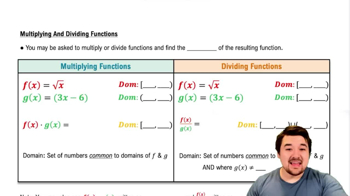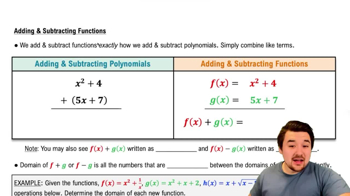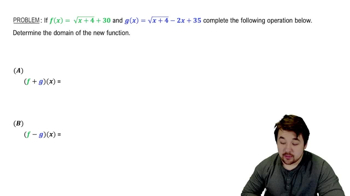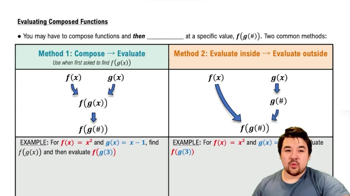Table of contents
- 0. Functions7h 52m
- Introduction to Functions16m
- Piecewise Functions10m
- Properties of Functions9m
- Common Functions1h 8m
- Transformations5m
- Combining Functions27m
- Exponent rules32m
- Exponential Functions28m
- Logarithmic Functions24m
- Properties of Logarithms34m
- Exponential & Logarithmic Equations35m
- Introduction to Trigonometric Functions38m
- Graphs of Trigonometric Functions44m
- Trigonometric Identities47m
- Inverse Trigonometric Functions48m
- 1. Limits and Continuity2h 2m
- 2. Intro to Derivatives1h 33m
- 3. Techniques of Differentiation3h 18m
- 4. Applications of Derivatives2h 38m
- 5. Graphical Applications of Derivatives6h 2m
- 6. Derivatives of Inverse, Exponential, & Logarithmic Functions2h 37m
- 7. Antiderivatives & Indefinite Integrals1h 26m
- 8. Definite Integrals4h 44m
- 9. Graphical Applications of Integrals2h 27m
- 10. Physics Applications of Integrals 2h 22m
0. Functions
Combining Functions
Problem 19b
Textbook Question
Composite functions
Let ƒ(x) = x³, g (x) = sin x and h(x) = √x .
Find h (ƒ (x)).
 Verified step by step guidance
Verified step by step guidance1
Step 1: Understand the problem. We are asked to find the composite function h(ƒ(x)), which means we need to substitute ƒ(x) into h(x).
Step 2: Identify the given functions. We have ƒ(x) = x^3 and h(x) = \sqrt{x}.
Step 3: Substitute ƒ(x) into h(x). This means replacing the x in h(x) with ƒ(x).
Step 4: Write the expression for the composite function. h(ƒ(x)) becomes h(x^3).
Step 5: Simplify the expression. Since h(x) = \sqrt{x}, h(x^3) becomes \sqrt{x^3}.
 Verified video answer for a similar problem:
Verified video answer for a similar problem:This video solution was recommended by our tutors as helpful for the problem above
Video duration:
3mPlay a video:
Was this helpful?
Key Concepts
Here are the essential concepts you must grasp in order to answer the question correctly.
Composite Functions
A composite function is formed when one function is applied to the result of another function. It is denoted as (f ∘ g)(x) = f(g(x)). Understanding how to combine functions is essential for evaluating expressions like h(f(x)), where the output of f(x) becomes the input for h.
Recommended video:

Evaluate Composite Functions - Special Cases
Function Notation
Function notation is a way to represent functions and their operations clearly. For example, f(x) represents the output of function f when x is the input. Recognizing how to read and interpret function notation is crucial for correctly applying functions in composite scenarios.
Recommended video:

Multiplying & Dividing Functions
Basic Functions and Their Properties
Familiarity with basic functions, such as polynomial functions (like f(x) = x³), trigonometric functions (like g(x) = sin x), and radical functions (like h(x) = √x), is vital. Each function has unique properties that affect how they interact in compositions, influencing the overall behavior of the composite function.
Recommended video:

Properties of Functions

 5:56m
5:56mWatch next
Master Adding & Subtracting Functions with a bite sized video explanation from Nick
Start learning



